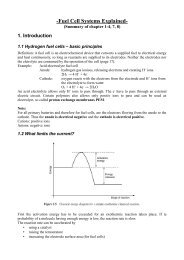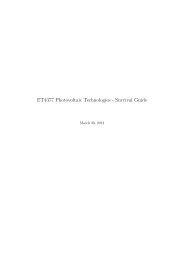Fuel Cell Systems Explained - from and for SET students
Fuel Cell Systems Explained - from and for SET students
Fuel Cell Systems Explained - from and for SET students
Create successful ePaper yourself
Turn your PDF publications into a flip-book with our unique Google optimized e-Paper software.
1.5 <strong>Fuel</strong> cell typesBesides the practical issuses fuel cells have to fundamental technical problems: slow reaction rate, low current <strong>and</strong> power hyrogen is not readily available as fuelThere are six viable systems of fuel cells:TypeAlkalineAFCProton exchangemembranPEMFCDirect methanolDMFCPhosporic acidPAFCMoltencarbonateMCFCMobileIonOperatingtemp. [°C]Anode <strong>and</strong> cathodereactionsApplication <strong>and</strong> notesOH - 50-200 Space vehiclesH + 30-100 2H 2 →4H + +4e - (a)O 2 +4H + +4e - →2H 2 O (c)Vehicles <strong>and</strong> mobileapplications, low power CHPH + 20-90 Portable electronic systems,low power but long runningtimeH + ca. 220 For small CHP plants(hundreds of kW), firstcommercial oneCO 32-ca. 650For medium to large CHP (upto MW)Solid OxideSOFCO 2- 500-1000 For all sizes of CHP (<strong>from</strong> kWto multi MW)Advantages <strong>and</strong> disadvantages are discussed later.1.6 Other cells – Some fuel cells, some not1. Biological fuel cellsuse an organic fuel, like methanol or ethanol, <strong>and</strong> enzymes to produce energy. Not yetcommercial2. Metal air cells (batteries)at the negative electrode the metal reacts with an alkaline electrolyte to <strong>for</strong>m metal oxide orhydroxide. The released eelctrons pass though an external electric circuit to the air cathode,where water <strong>and</strong> oxygen reacts to hydroxyl ions (see alkaline fuel cell). Metal oxide isdissolved into the electrolyte, which have to be renewed after some time. Consumption ofanode <strong>and</strong> electrolyte.Very good energy densitiy: commercial <strong>for</strong> low power applications with long running time.Research <strong>for</strong> higher power <strong>for</strong> electric vehicles.3. Reodx flow cells or regenerative fuel cellsFor charging the reactants are removed <strong>from</strong> the electrodes <strong>and</strong> stored in a tank. Fordischarging the electrolytes are supplied back to the electrodes. Is used <strong>for</strong> very largecapacity rechargeable batteries. The electrocolyte changes during operation <strong>and</strong> the systemcannot work idenfinitely.






